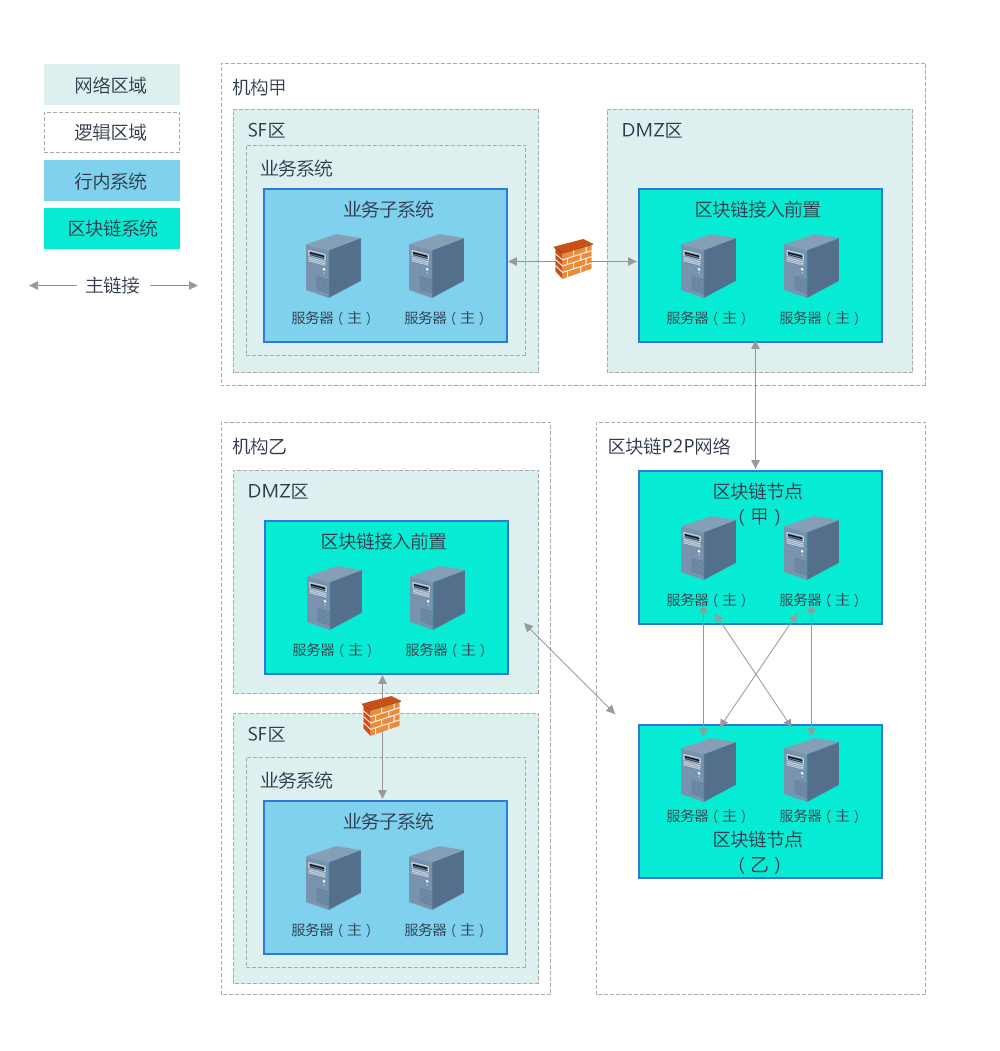链上信使协议AMOP使用指南¶
作者:fisco-dev
介绍¶
链上信使协议AMOP(Advanced Messages Onchain Protocol)系统旨在为联盟链提供一个安全高效的消息信道,联盟链中的各个机构,只要部署了区块链节点,无论是共识节点还是观察节点,均可使用AMOP进行通讯,AMOP有如下优势:
- 实时:AMOP消息不依赖区块链交易和共识,消息在节点间实时传输,延时在毫秒级。
- 可靠:AMOP消息传输时,自动寻找区块链网络中所有可行的链路进行通讯,只要收发双方至少有一个链路可用,消息就保证可达。
- 高效:AMOP消息结构简洁、处理逻辑高效,仅需少量cpu占用,能充分利用网络带宽。
- 安全:AMOP的所有通讯链路使用SSL加密,加密算法可配置。
- 易用:使用AMOP时,无需在SDK做任何额外配置。
逻辑架构¶

以银行典型IDC架构为例,各区域概述:
- SF区:机构内部的业务服务区,此区域内的业务子系统使用区块链SDK,如无DMZ区,配置SDK连接到区块链节点,反之配置SDK连接到DMZ区的区块链前置。
- DMZ区:机构内部的外网隔离区,非必须,如有,该区域部署区块链前置。
- 区块链P2P网络:此区域部署各机构的区块链节点,此区域为逻辑区域,区块链节点也可部署在机构内部。
配置¶
AMOP无需任何额外配置,以下为SDK的配置案例 SDK配置(Spring Bean):
<?xml version="1.0" encoding="UTF-8" ?>
<beans xmlns="http://www.springframework.org/schema/beans"
xmlns:xsi="http://www.w3.org/2001/XMLSchema-instance" xmlns:p="http://www.springframework.org/schema/p"
xmlns:tx="http://www.springframework.org/schema/tx" xmlns:aop="http://www.springframework.org/schema/aop"
xmlns:context="http://www.springframework.org/schema/context"
xsi:schemaLocation="http://www.springframework.org/schema/beans
http://www.springframework.org/schema/beans/spring-beans-2.5.xsd
http://www.springframework.org/schema/tx
http://www.springframework.org/schema/tx/spring-tx-2.5.xsd
http://www.springframework.org/schema/aop
http://www.springframework.org/schema/aop/spring-aop-2.5.xsd">
<!-- AMOP消息处理线程池配置,根据实际需要配置 -->
<bean id="pool" class="org.springframework.scheduling.concurrent.ThreadPoolTaskExecutor">
<property name="corePoolSize" value="50" />
<property name="maxPoolSize" value="100" />
<property name="queueCapacity" value="500" />
<property name="keepAliveSeconds" value="60" />
<property name="rejectedExecutionHandler">
<bean class="java.util.concurrent.ThreadPoolExecutor.AbortPolicy" />
</property>
</bean>
<!-- 区块链节点信息配置 -->
<bean id="channelService" class="org.bcos.channel.client.Service">
<property name="orgID" value="WB" /> <!-- 配置本机构名称 -->
<property name="allChannelConnections">
<map>
<entry key="WB"> <!-- 配置本机构的区块链节点列表(如有DMZ,则为区块链前置)-->
<bean class="org.bcos.channel.handler.ChannelConnections">
<property name="connectionsStr">
<list>
<value>NodeA@127.0.0.1:30333</value><!-- 格式:节点名@IP地址:端口,节点名可以为任意名称 -->
</list>
</property>
</bean>
</entry>
</map>
</property>
</bean>
</bean>
区块链前置配置,如有DMZ区:
<?xml version="1.0" encoding="UTF-8" ?>
<beans xmlns="http://www.springframework.org/schema/beans"
xmlns:xsi="http://www.w3.org/2001/XMLSchema-instance" xmlns:p="http://www.springframework.org/schema/p"
xmlns:tx="http://www.springframework.org/schema/tx" xmlns:aop="http://www.springframework.org/schema/aop"
xmlns:context="http://www.springframework.org/schema/context"
xsi:schemaLocation="http://www.springframework.org/schema/beans
http://www.springframework.org/schema/beans/spring-beans-2.5.xsd
http://www.springframework.org/schema/tx
http://www.springframework.org/schema/tx/spring-tx-2.5.xsd
http://www.springframework.org/schema/aop
http://www.springframework.org/schema/aop/spring-aop-2.5.xsd">
<!-- 区块链节点信息配置 -->
<bean id="proxyServer" class="org.bcos.channel.proxy.Server">
<property name="remoteConnections">
<bean class="org.bcos.channel.handler.ChannelConnections">
<property name="connectionsStr">
<list>
<value>NodeA@127.0.0.1:5051</value><!-- 格式:节点名@IP地址:端口,节点名可以为任意名称 -->
</list>
</property>
</bean>
</property>
<property name="localConnections">
<bean class="org.bcos.channel.handler.ChannelConnections">
</bean>
</property>
<!-- 区块链前置监听端口配置,区块链SDK连接用 -->
<property name="bindPort" value="30333"/>
</bean>
</beans>
SDK使用¶
AMOP的消息收发基于topic(主题)机制,服务端首先设置一个topic,客户端往该topic发送消息,服务端即可收到。
AMOP支持在同一个区块链网络中有多个topic收发消息,topic支持任意数量的服务端和客户端,当有多个服务端关注同一个topic时,该topic的消息将随机下发到其中一个可用的服务端。
服务端代码案例:
package org.bcos.channel.test;
import java.util.ArrayList;
import java.util.List;
import org.slf4j.Logger;
import org.slf4j.LoggerFactory;
import org.springframework.context.ApplicationContext;
import org.springframework.context.support.ClassPathXmlApplicationContext;
import org.bcos.channel.client.Service;
public class Channel2Server {
static Logger logger = LoggerFactory.getLogger(Channel2Server.class);
public static void main(String[] args) throws Exception {
if(args.length < 1) {
System.out.println("参数: 接收topic");
return;
}
String topic = args[0];
ApplicationContext context = new ClassPathXmlApplicationContext("classpath:applicationContext.xml");
Service service = context.getBean(Service.class);
//设置topic,支持多个topic
List<String> topics = new ArrayList<String>();
topics.add(topic);
service.setTopics(topics);
//处理消息的PushCallback类,参见Callback代码
PushCallback cb = new PushCallback();
service.setPushCallback(cb);
//启动服务
service.run();
}
}
服务端的PushCallback类案例:
package org.bcos.channel.test;
import java.time.LocalDateTime;
import java.time.format.DateTimeFormatter;
import org.slf4j.Logger;
import org.slf4j.LoggerFactory;
import org.bcos.channel.client.ChannelPushCallback;
import org.bcos.channel.dto.ChannelPush;
import org.bcos.channel.dto.ChannelResponse;
class PushCallback extends ChannelPushCallback {
static Logger logger = LoggerFactory.getLogger(PushCallback2.class);
//onPush方法,在收到AMOP消息时被调用
@Override
public void onPush(ChannelPush push) {
DateTimeFormatter df = DateTimeFormatter.ofPattern("yyyy-MM-dd HH:mm:ss");
logger.debug("收到PUSH消息:" + push.getContent());
System.out.println(df.format(LocalDateTime.now()) + "server:收到PUSH消息:" + push.getContent());
//回包消息
ChannelResponse response = new ChannelResponse();
response.setContent("receive request seq:" + String.valueOf(push.getMessageID()));
response.setErrorCode(0);
push.sendResponse(response);
}
}
客户端案例:
package org.bcos.channel.test;
import java.time.LocalDateTime;
import java.time.format.DateTimeFormatter;
import java.util.Date;
import java.util.Random;
import org.slf4j.Logger;
import org.slf4j.LoggerFactory;
import org.springframework.context.ApplicationContext;
import org.springframework.context.support.ClassPathXmlApplicationContext;
import org.bcos.channel.client.Service;
import org.bcos.channel.dto.ChannelRequest;
import org.bcos.channel.dto.ChannelResponse;
public class Channel2Client {
static Logger logger = LoggerFactory.getLogger(Channel2Client.class);
public static void main(String[] args) throws Exception {
if(args.length < 1) {
System.out.println("参数: 目标topic");
return;
}
String topic = args[0];
DateTimeFormatter df = DateTimeFormatter.ofPattern("yyyy-MM-dd HH:mm:ss");
ApplicationContext context = new ClassPathXmlApplicationContext("classpath:applicationContext.xml");
Service service = context.getBean(Service.class);
service.run();
Thread.sleep(2000); //建立连接需要一点时间,如果立即发送消息会失败
ChannelRequest request = new ChannelRequest();
request.setToTopic(topic); //设置消息topic
request.setMessageID(service.newSeq()); //消息序列号,唯一标识某条消息,可用newSeq()随机生成
request.setTimeout(5000); //消息的超时时间
request.setContent("request seq:" + request.getMessageID()); //发送的消息内容
ChannelResponse response = service.sendChannelMessage2(request); //发送消息
System.out.println(df.format(LocalDateTime.now()) + "收到回包 seq:" + String.valueOf(response.getMessageID()) + ", 错误码:" + response.getErrorCode() + ", 内容:" + response.getContent());
}
}
测试¶
按上述说明配置好后,用户指定一个主题:topic,执行以下两个命令可以进行测试。
启动amop服务端:
java -cp 'conf/:apps/*:lib/*' org.bcos.channel.test.Channel2Server [topic]
启动amop客户端:
java -cp 'conf/:apps/*:lib/*' org.bcos.channel.test.Channel2Client [topic] [消息内容] [消息条数]
错误码¶
- 99:发送消息失败,AMOP经由所有链路的尝试后,消息未能发到服务端,建议使用发送时生成的seq,检查链路上各个节点的处理情况。
- 102:消息超时,建议检查服务端是否正确处理了消息,带宽是否足够。